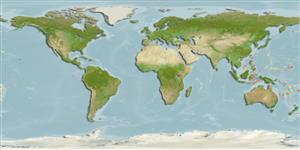Elasmobranchii (hajar och rockor) (sharks and rays) >
Squaliformes (Sleeper and dogfish sharks) >
Centrophoridae (Gulper sharks)
Etymology: Centrophorus: centr[um] (L.), prickle or sharp point; phorus, from phoreus (Gr.), bearer or carrier, referring to grooved spines on dorsal fins. (See ETYFish); longipinnis: longus (L.), long; pinnis (L.) fins, referring to very distinctive long-based first dorsal fin. (See ETYFish).
Environment: milieu / climate zone / depth range / distribution range
Ekologi
marina djupbottenlevande; djupintervall 330 - 460 m (Ref. 116740). Tropical
Utbredning
Länder | FAO områden | Ekosystem | Förekomster | Point map | Utplanteringar | Faunafri
Western Pacific: Taiwan, Indonesia and Papua New Guinea.
Size / Vikt / Age
Maturity: Lm ? range ? - ? cm
Max length : 77.5 cm TL hane/ej könsbestämd; (Ref. 116740); 93.0 cm TL (female)
Short description
Morfologi | Morfometri
This medium sized (<1 m maximum total length) species is distinguished by the following
set of characters: body relatively slender and head moderately long (20.5-25.1% TL); snout relatively short (horizontal preorbital length 6.4-8.4% TL) and is rounded in dorsal view; the first dorsal is extremely long based (base length 20.8-23.3% TL, soft fin length 16.9-20.2% TL) and relatively high (height 5.7-7.2% TL), the inner margin relatively short (5.3-6.8% TL, 2.6-3.2 in soft fin length); second dorsal fin is much smaller in area to first, similar in height to first dorsal fin (height 1.0-1.3 in first dorsal-fin height); pectoral fins large (anterior margin length 11.0-13.0% TL), free rear tip elongate in larger individuals (2.2-4.0% TL); lateral trunk denticles of larger individuals are sessile (not raised on pedicels), block-like, not elevated; upper teeth of larger individuals with erect to slightly oblique cusps; lower teeth of all sized specimens are much larger than upper teeth, strongly oblique, blade-like; total vertebral centra 112-122; teeth 38-43/29-31 (Ref. 116740).
Life cycle and mating behavior
Könsmognad | Reproduktion | Lek | Ägg | Fecundity | Larver
White, W.T., D.A. Ebert and G.J.P. Naylor, 2017. Revision of the genus Centrophorus (Squaliformes: Centrophoridae): Part 2 - Description of two new species of Centrophorus and clarification of the status of Centrophorus lusitanicus Barbosa du Bocage & de Brito Capello, 1864. Zootaxa 4344(1):086-114. (Ref. 116740)
IUCN Red List Status (Ref. 130435)
Threat to humans
Harmless
Human uses
Ytterligare information
LänderFAO områdenEkosystemFörekomsterUtplanteringarStocksEkologiFödaFödoslagFödointagNäringsinnehåll
PopulärnamnsynonymerMetabolikPredatorerEkotoxikologiReproduktionKönsmognadLekSpawning aggregationFecundityÄggEgg development
Age/SizeTillväxtLength-weightLength-lengthLength-frequenciesMorfometriMorfologiLarverLarvdynamikRekryteringAbundansBRUVS
referenserVattenbrukVattenbruksprofilAvelslinjerGenetikElectrophoresesÄrftlighetSjukdomarBehandlingNutrientsMass conversion
MedarbetareBilderStamps, Coins Misc.LjudCiguateraHastighetSimsättGälytaOtolithsHjärnstorlekSyn
Verktyg
Special reports
Download XML
Internet-källor
Estimates based on models
Phylogenetic diversity index (Ref.
82804): PD
50 = 0.5001 [Uniqueness, from 0.5 = low to 2.0 = high].
Bayesian length-weight: a=0.01122 (0.00514 - 0.02450), b=3.04 (2.87 - 3.21), in cm total length, based on all LWR estimates for this body shape (Ref.
93245).
Trofisk nivå (Ref.
69278): 4.3 ±0.3 se; based on size and trophs of closest relatives
Resiliens (Ref.
120179): Mycket låg, lägsta populationsfördubblingstid mer än 14 år (Preliminary K or Fecundity.).
Fishing Vulnerability (Ref.
59153): High vulnerability (57 of 100).
